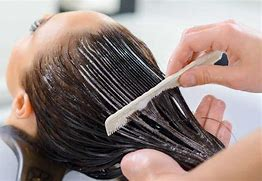Easy Ways to Make Your Hair Look Thicker
Sometimes, a smart haircut is the easiest way to make hair look fuller. A good cut can trick the eye into seeing more volume and thickness.
Straight blunt cuts: These make the ends look thicker.
Layers: Add layers in the right places, like around the top of your head. This gives movement and body without making hair shorter.
Bangs or fringe: These frame your face and make the front look fuller.
Regular trims: Cut off split ends often. This stops breakage from moving up the hair. Breakage makes hair look thinner. Many people say getting trims helps keep hair healthy and stops it from looking thin.
10. Be Careful with Chemical Treatments
Things like hair colour or perms can change your look, but they can hurt the hair a lot. This causes breakage and makes hair look thinner. If your hair is getting thin, stop using dye or bleach for a while. Let your hair rest and get better.
If you do these treatments a lot:
Go to a good stylist who knows how to do it safely.
Use special products that fix and strengthen the hair bonds broken by chemicals.
Do treatments less often. Give your hair time to recover.
Use deep conditioner often. This adds water and strength to your hair.
Best Products for Thicker Hair
At Millies.ie, we pick the best professional hair products to help you get fuller hair. Here are some top ones that give volume, thickness, and strength.
Kérastase Genesis
This line is made to stop hair from falling out because of breakage. It is great for weak hair. The shampoos, conditioners, and treatments clean gently and make hair stronger. This gives thicker-looking hair.
Redken Volume Injection
This gives quick lift and lasting body. It is perfect for fine or flat hair. The shampoo and conditioner clean and feed the hair. They add lift at the roots, shine, and a nice finish.
Pureology Pure Volume
These products add volume without bad stuff. They are 100% vegan, no sulfates, and no parabens. They have nice smells. Your hair will feel full, thick, and full of life. They also protect colour.
Eleven: I Want Volume
If you want a lot of body, try this. It is good for fine hair or if you want big volume. It gives clear fullness and control. Styling big hair is easy.
Texturising Dry Shampoos
These are great for quick volume. Put them on the roots. They take away extra oil, add grip, and give instant lift and texture. Hair looks fuller right away. Use them on day-two hair or before styling.
Thicker Hair FAQs
How to thicken hair naturally?
Take care of your scalp. Massage it gently. Use natural things like rosemary oil (mix it with water first). Eat foods with lots of protein, iron, and vitamins. Use less heat tools and chemical treatments.
Best shampoos for thicker hair?
Choose ones that say "volumising" or "thickening." Look for things like polymers and proteins in them. Good ones at Millies.ie are Kérastase Genesis, Redken Volume Injection, and Pureology Pure Volume. Many people also like Nioxin.
Best supplements for thicker hair?
Try Biotin, Collagen, marine protein, and vitamins like Iron and Zinc. Many people say Collagen helps a lot. Iron is important if you don't have enough.
Quick Summary: How to Get Thicker Hair
To get thicker hair, do many things together. Use shampoos and conditioners that add volume. Take good care of your scalp with massages and treatments like rosemary oil. Use strong hair masks. Protect hair from heat and dry it gently. Eat healthy food and maybe take supplements like collagen. Lower stress, get good haircuts, and stay away from strong chemicals. Keep doing it every day. You will see fuller hair over time




















